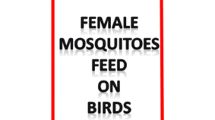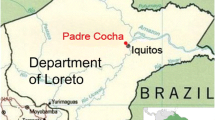Abstract
Rift valley fever (RVF) is a disease killing principally animals. In this article, we coupled a mathematical model of animal-mosquito interactions with an agent-based model describing the migrations of hosts between cities. The mathematical model describes animal-mosquito interactions in each city and the agent based-model describes the migrations of animals between cities. The coupled model allows to compute at each time the number of infected animals in all cities and to study the impact of host migrations on the dynamics of infections. The obtained results showed that quarantining certain cities can reduce the number of infected hosts. It is also observed that when the density of animal migrations increases, the number of infection cases increases. The developed model brings solutions to both models (mathematical model and agent-based model) limits. This model could help to study and forecasting the Rift Valley Fever transmission and its outbreak in the short and long term.
Access this chapter
Tax calculation will be finalised at checkout
Purchases are for personal use only
Similar content being viewed by others
References
Murgue, B., Zeller, H., Deubel, V.: The ecology and epidemiology of West Nile virus in Africa, Europe and Asia. In: Mackenzie, J.S., Barrett, A.D.T., Deubel, V. (eds.) Japanese Encephalitis and West Nile Viruses. Current Topics in Microbiology and Immunology, vol. 267, pp. 195–221. Springer, Heidelberg (2002). https://doi.org/10.1007/978-3-642-59403-8_10
Zeller, H.G., Schuffenecker, I.: West Nile virus: an overview of its spread in Europe and the Mediterranean basin in contrast to its spread in the Americas. Eur. J. Clin. Microbiol. Infect. Dis. 23(3), 147–156 (2004)
Iggidr, A., Sallet, G., Souza, M.O.: Analysis of the dynamics of a class of models for vector-borne diseases with host circulation. Research Report RR-8396, INRIA, p. 20 (2013)
Adams, B., Kapan, D.D.: Man bites mosquito: understanding the contribution of human movement to vector-borne disease dynamics. PLoS ONE 4(8), e6763 (2009)
Alvim, M., Iggidr, A., Koiler, J., Sallet, G., Penna, M.L.F., Souza, M.O.: Onset of a vector borne disease due to human circulation-uniform, local and network reproduction ratios. Preprint HAL (2013)
Gaff, H.D., Hartley, D.M., Leahy, N.P.: Electron. J. Differ. Equ. 2007(115), 1–12 (2007). ISSN 1072-669
Gao, D., Cosner, C., Cantrell, R.S., Beier, J.C., Ruan, S.: Modeling the spatial spread of rift valley fever in Egypt. Bull. Math. Biol. 75(3), 523–542 (2013)
Mpeshe, S.C., Haario, H., Tchuenche, J.M.: A mathematical model of Rift Valley fever with human host. Acta. Biotheor. 59, 231–250 (2011)
Xue, L., Scott, H.M., Cohnstaedt, L.W., Scoglio, C.: A network-based meta-population approach to model Rift Valley fever epidemics. J. Theor. Biol. 306, 129–144 (2012)
Xue, L., Cohnstaedt, L.W., Scott, H.M., Scoglio, C.: A hierarchical network approach for modeling Rift Valley fever epidemics with applications in North America. PLoS ONE 8(5), e62049 (2013). https://doi.org/10.1371/journal.pone.0062049
Niu, T., Gaff, H.D., Papelis, Y.E., Hartley, D.M.: An epidemiological model of rift valley fever with spatial dynamics. Comput. Math. Methods Med. 2012(2012), Article ID 138757, 12 p. (2012)
Roche, B., Guégan, J.-F., Bousquet, F.: Multi-agent systems in epidemiology: a first step for computational biology in the study of vector-borne disease transmission. BMC Bioinform. 9, 435 (2008)
Paul, P.N.T., Bah, A., Ndiaye, P.I., Ndione, J.A.: An agent-based model for studying the impact of herd mobility on the spread of vector-borne diseases: the case of rift valley fever (Ferlo Senegal). Open J. Model. Simul. 2, 97–111 (2014). https://doi.org/10.4236/ojmsi.2014.23012
Sukumar, S.R., Nutaro, J.J.: Agent-based vs. equation-based epidemiological models: a model selection case study, pp. 74–79. IEEE, December 2012
Paul, P.N.T., Bah, A., Ndiaye, P.I., Dione, J.A.: Coupling of an agent-based model with a mathematical model of water pond dynamics for studying the impact of animal herd mobility on the Aedes vexans mosquito populations. J. Mosquitoes Res. 4(3), 132–141 (2017)
Paul, P.N.T., Bah, A., Ndiaye, P.I., Ndione, J.A.: An agent based model to study the impact of intra-annual season’s variability on the dynamics of Aedes Vexans and Culex Poicilipes mosquito populations in North Senegal (Ferlo). In: Silhavy, R., Silhavy, P., Prokopova, Z. (eds.) CoMeSySo 2017. AISC, vol. 662, pp. 381–391. Springer, Cham (2018). https://doi.org/10.1007/978-3-319-67621-0_35
van den Driessche, P., Watmough, J.: Math. Biosci. 180, 29–48 (2002)
Common-pool Resources and Multi-Agent Simulations. http://cormas.cirad.fr
Pratt, H.D., Moore, C.G.: Vector-Borne Disease Control: Mosquitoes, of Public Health Importance and their Control. U.S. Department of Health and Human Services, Atlanta, GA (1993)
Bates, M.: The Natural History of Mosquitoes. Peter Smith, Gloucester (1970)
Moore, C.G., et al.: Guidelines for Arbovirus Surveillance Programs in the United Sates. Center for Disease Control and Prevention, April 1993
Radostits, O.M.: Herd Healthy: Food Animal Production Medicine, 3rd edn. W. B. Saunders Company, Philidelphia (2001)
Turell, M.J., Kay, B.H.: Susceptibility of slected strains of Australian mosquitoes (Diptera: Culicidae) to Rift Valley fever virus. J. Med. Entomol. 35(2), 132–135 (1998)
Peters, C.J., Linthicum, K.J.: Rift Valley fever. In: Beran, G.W. (ed.) Handbook of Zoonoses, B: Viral, 2nd edn, pp. 125–138. CRC Press (1994)
Freier, J.E., Rosen, L.: Verticle transmission of dengue virus by the mosquitoes of the Aedes scutellaris group. Am. J. Trop. Med. Hyg. 37(3), 640–647 (1987)
Anderson, R.M., May, R.M.: Infectious Diseases of Humans: Dynamics and Control. Oxford University Press, Oxford (1991)
Heffernan, J.M., Smith, R.J., Wahl, L.M.: Perspectives on the basic reproductive ratio. J. R. Soc. Interface 2, 281–293 (2005). EJDE-2007/115 AN EPIDEMIOLOGICAL MODEL 11
Lipsitch, M., Nowak, M.A., Ebert, D., May, R.M.: The population dynamics of vertically and horizontally transmitted parasites. Proc. R. Soc. B 260, 321–327 (1995)
Diekmann, O., Heesterbeek, J.A., Metz, J.A.: On the denotion and the computation of the basic reproduction ratio R0 in models for infectious diseases in heterogeneous populations. J. Math. Biol. 28(4), 365–382 (1990). https://doi.org/10.1007/BF00178324. ISSN 0303-6812
Barker, C., Niu, T., Reisen, W., Hartley, D.M.: Data-driven modeling to assess receptivity for rift valley fever virus. PLoS Neglected Trop. Dis. 7(11), e2515 (2013). https://doi.org/10.1371/journal.pntd.0002515
https://www.collinsdictionary.com/dictionary/english/livestock
Canyon, D.V., Hii, J.L.K., Muller, R.: The frequency of host biting and its effect on oviposition and survival in Aedes aegypti (Diptera: Culicidae). Bull. Entomol. Res. 89(1), 35–39 (1999)
Hayes, R.O., Tempelis, C.H., Hess, A.D., Reeves, W.C.: Mosquito host preference studies in Hale County, Texas. Am. J. Trop. Med. Hyg. 22(2), 270–277 (1973)
Jones, C.J., Lloyd, J.E.: Mosquitoes feeding on sheep in southeastern Wyoming. J. Am. Mosquito Control Assoc. 1(4), 530–532 (1985)
Magnarelli, L.A.: Host feeding patterns of Connecticut mosquitoes (Diptera: Culicidae). Am. J. Trop. Med. Hyg. 26(3), 547–552 (1977)
Pratt, H.D., Moore, C.G.: Vector-Borne Disease Controls: Mosquitoes, of Public Health Importance and Their Control, U.S. Department of Health and Human Services, Atlanta, Ga, USA (1993)
Turell, M.J., Bailey, C.L., Beaman, J.R.: Vector competence of a Houston, Texas strain of Aedes albopictus for Rift Valley fever virus. J. Am. Mosquito Control Assoc. 4(1), 94–96 (1988)
Turell, M.J., Faran, M.E., Cornet, M., Bailey, C.L.: Vector competence of senegalese Aedes fowleri (Diptera: Culicidae) for Rift Valley fever virus. J. Med. Entomol. 25(4), 262–266 (1988)
Wen, B., Teng, Z., Liu, W.: Threshold dynamics in a periodic three-patch rift valley fever virus transmission model. Complexity 2019, Article ID 7896946, 18 p. (2019). https://doi.org/10.1155/2019/7896946
Author information
Authors and Affiliations
Corresponding author
Editor information
Editors and Affiliations
Rights and permissions
Copyright information
© 2020 Springer Nature Switzerland AG
About this paper
Cite this paper
Python Ndekou Tandong, P., Ndiaye, P.I., Bah, A., Dione, D., Ndione, J.A. (2020). Coupling an Agent-Based Model with a Mathematical Model of Rift Valley Fever for Studying the Impact of Animal Migrations on the Rift Valley Fever Transmission. In: Gervasi, O., et al. Computational Science and Its Applications – ICCSA 2020. ICCSA 2020. Lecture Notes in Computer Science(), vol 12250. Springer, Cham. https://doi.org/10.1007/978-3-030-58802-1_34
Download citation
DOI: https://doi.org/10.1007/978-3-030-58802-1_34
Published:
Publisher Name: Springer, Cham
Print ISBN: 978-3-030-58801-4
Online ISBN: 978-3-030-58802-1
eBook Packages: Computer ScienceComputer Science (R0)




